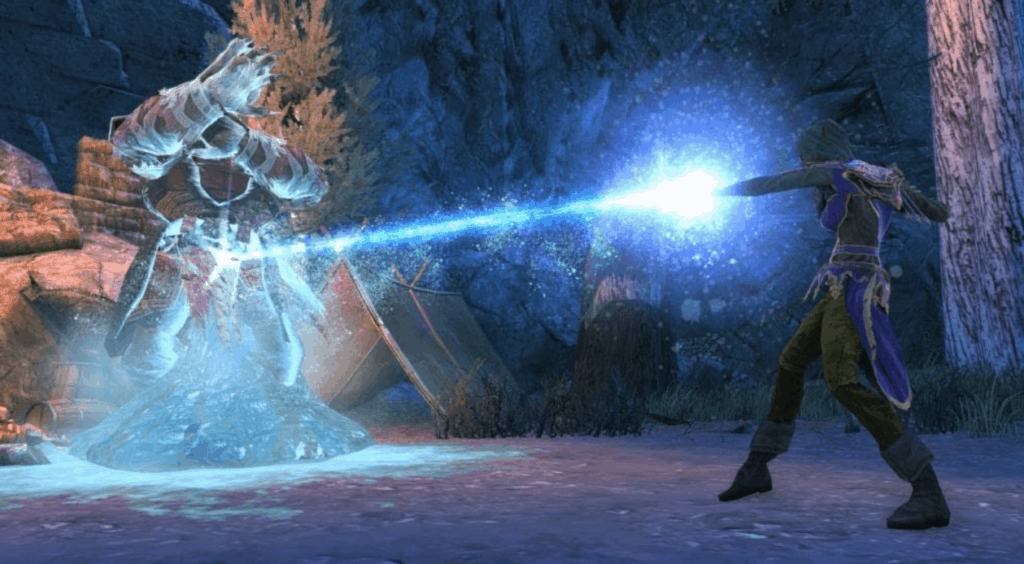There are 13 main damage types in D&D: acidity, bludgeoning, cold, fire, force, lightning, necrotic, piercing, toxin, psychic, radiant, slashing, and thunder. Of these types, every monster, NPC, and even your PCs might have some resistances, vulnerabilities, and even immunities to these types of damages. Now, what if there was another way you could handle these damage types?
The next time a fireball spell is thrown at you, or you are about to get a bolt of lightning through the body, then you might want to consider using Absorb Elements. Now, this spell name is very interesting and comes with a lot of implications for you.
What damage types does the spell work with? How does the spell work? Plus, once you have absorbed the elements, what happens with all that excess energy? Read our Absorb Elements 5e guide and find out!
What Is Absorb Elements?
This is another spell from Xanathar’s Guide to Everything, and here are the stats for the spell:
- level 1 – abjuration
- Casting Time: 1 reaction, which you take when you take acid, cold, fire, lightning, or thunder damage
- Spell List: Druid, Ranger, Sorcerer, Wizard, Artificer
- Range: Self
- Components: S
- Duration: 1 round
This D&D spell captures some of the incoming energy, lessening its effect on you and storing it for your next melee attack. You have resistance to the triggering damage type until the start of your next turn. Also, the first time you hit with a melee attack on your next turn, the target takes an extra 1d6 damage of the triggering type, and the spell ends.
At Higher Levels. When you cast this spell using a spell slot of 2nd level or higher, the extra damage increases by 1d6 for each slot level above 1st.
Alright, let’s break this spell down. First, it is a first-level abjuration spell that needs a reaction to be cast. Whenever you take acid, cold, fire, lightning, or thunder damage, you can cast the spell. It only requires a somatic component, and it does last for one round.
Whenever you are hit with these types of energy, you are given two effects. You have resistance from the damage type until the start of your next turn, and then you can store some of the energy. Whenever you hit the target with a melee attack, then in addition to regular damage, the target will take an extra 1d6 of that damage type. The spell can then be upcasted for more stored damage.
For example, let’s say that you get hit with a fireball. You can cast the spell and then absorb some of that fire energy.
You are able to resist the fire damage until your next turn and then take all the absorbed energy. If you manage to get close to an enemy, you will be able to channel that energy into your melee attack. This gives you an extra 1d6 fire damage to your attack for that attack, and then the spell ends.
It’s a lot of fun, and you will find that being able to absorb elements is a very fun thing to do whenever the damage matches up.
Getting Resistance

There are two parts to this spell, with the first being defensive. You will gain resistance to the chosen damage type whenever you cast this spell using a reaction. Your somatic movement and the spell will absorb some of the energy, making sure that the spell only deals half damage to you. So a fireball that does 36 points of damage will now only do 18.
You will also get resistance to the chosen damage type until the start of your next turn, so if you are fighting your way through several enemies that are using the same element, you have a bit of a respite.
Dealing Damage
In order to deal damage to your enemy, you need to make a melee attack, which can be a pretty big problem since the majority of the people able to cast this spell are casters or ranged fighters. If your entire combat strategy involves being near the back and letting others take the knocks for you, then you might have a problem getting close enough to whack someone with your melee weapon.
Still, if you aren’t a stranger to melee combat despite being a caster, then this can be perfect for you. You absorb the elemental damage of the attack and then send it right back towards the enemy with your strike. You get 1d6 worth of damage of the elemental damage type and more if you upcast the spell.
The one problem with elemental damage for monsters is that if they can strike with the elemental damage, they are resistant to it as well. A Fire demon can throw a fireball, but they can also take one as they are resistant, and some are even immune to their elemental damage. Keep that in mind because you might be absorbing damage you can’t fire back.
Using Absorb Elements Against Humanoid Characters

Now, as you know, elementals and monsters aren’t the only ones who can cast elemental magic. You might find that a bandit king has a magical weapon or potion that allows them to cast one of these damage types. Or maybe a gnoll or ogre has managed to get their hands on a ring of fireball and is using it indiscriminately. This is where the spell shines because you can absorb the elemental energy and then fire it back at the enemy, who has absolutely no resistance to the element.
It’s a pretty fun spell to bounce a spell back and watch your enemy’s face as you do so! Plus, it’s a great idea for an adventure if you have mundane enemies get their hands on magical weapons and abilities. It will certainly spice up the 100th goblin encounter you’ve had!
How Do Reactions Work?
Now, you have probably seen spells that cost actions to cast, as well as bonus actions. However, Absorb Elements is a spell that takes a reaction to deal with. What is a reaction in D&D? According to the rules, here is the description for a reaction:
A reaction is an instant response to a trigger of some kind, which can occur on your turn or on someone else’s. This includes opportunity attacks that are made when enemies leave your zone, a readied action that has a trigger attached, and of course, spells that have readied actions. Now, whenever an enemy hits you with one of the six damage types, that’s the trigger that allows you to cast the spell.
You can cast the spell on the enemy’s turn, and your reaction doesn’t cost any of your regular actions. So you will still be able to take your two movement actions and your attack action when it is your turn. You’ll know when you can cast this spell, and as long as you have the 1st level spell slot, you will be able to absorb the elemental damage of the attack.
Can Spells Be Infused With Elemental Energy?

According to the rules as written, no, your spells are kept free from the elemental energy. So if you are a sorcerer, you won’t be able to throw that extra fire energy into your next spell, even if it is a fire spell. Sadly, the elemental energy only transfers to your dagger, which might not be the best thing for you. Most sorcerers aren’t going to throw themselves into the path of a monster with a dagger that does an extra D6 acid damage.
Some DM’s might make it, so the excess energy flies through your spells, despite the elements. It might be a little silly to be a cryomancer and then throw fire energy with your next ray of frost attack. Still, they might rule that an extra d6 of damage is added onto your next spell to represent the boost in magical energy you are getting.
It’s a good house rule to have, but again it will depend on your players and how they feel, as well as how often they find themselves using the spell. Still, no matter what happens offensively, the defensive capabilities of the spell are still pretty good. No one is going to turn up their nose to some elemental resistance.
Continue reading about Daggers in DnD 5e.
Absorb Elements FAQ
Question: How Does Absorb Elements Look?
Answer: In a few words, pretty freaken cool! Your characters can do a lot with the description of the spell. Some characters might raise their hands and push back against the elemental attack, absorbing the worst of the energy. Artificers might deploy some gadget or shield that lets them catch the attack, still taking the damage before firing it back.
It will also depend on if they were hit at the range or in melee with the attack as well. If in melee, a druid might decide to weave some mystical grass or tree branches together to catch the sword swing or magical axe blow or maybe use nature to enhance their armor.
You can do just about anything your character would do to absorb the brunt of the attack, but the description doesn’t need to stop there. They can then be glowing with fire or cold or thunder energy, and maybe their weapon is very briefly illuminated in that energy too. Then when they strike out, all that power is sent back into the enemy.
Question: What About The Other Damage Types?
Answer: Well, you have probably noticed that only five damage types are affected by the Absorb Elements spell: acid, cold, fire, lightning, or thunder damage. That leaves bludgeoning, force, necrotic, piercing, toxin, psychic, radiant, and slashing. There are reasons why these damage types are left out if you choose to think about them.
First, there’s bludgeoning, piercing, and slashing. These two damage types have no magic behind them; it’s just your character getting hit in the face with a sword or a mace. No magic, just muscle, and there’s nothing to absorb.
Psychic damage and toxin damage tend to affect the mind and the body quickly. If you are poisoned, there’s not much to resist, and you are often too busy fighting the poison to think about sending it back. It’s the same with physic damage, as that is mind to mind, and you can’t reliably channel that into a melee weapon strike.
Radiant and necrotic are simply too powerful to be absorbed. While things like fire and cold are not only commonly found in nature, they are also things we can feel on our own. You can stand next to a fire and get burned or in a snowstorm and get cold. However, radiant and necrotic damage are powers that are attached to something higher.
Absorbing the power of a good or evil deity without being prepared to take on that power can be detrimental, and you probably don’t have the focus or control necessary to focus that power into your weapon and strike back at your enemy with it.
These are some of the reasons DM’s think up to explain away the rule restriction, and it’s certainly a lot better than saying: “Because that’s how the rules work!”
Question: When Should You Use Absorb Elements?
Answer: This spell does take a reaction, so it is best to use it whenever powerful elemental attacks come your way. If you can’t reliably take an elemental hit and have failed the saving throw to half or avoid the damage, then you should probably try to absorb what you can. Note that the spell says the trigger is whenever you take damage, so you can still try to roll your saving throws to avoid the damage before casting the spell.
This certainly helps whenever you make a saving throw to half the damage and with Absorb.
Elements, you get to half the damage again. If you don’t feel confident in your dice rolls or your HP, then you need to be using this spell to even the odds.
- DnD Demons Guide: What Are Demons in 5e? - September 18, 2021
- Detect Thoughts 5e Guide: When, Why and How to Use It - September 9, 2021
- The Ultimate DnD Toll the Dead 5e Guide - September 9, 2021

